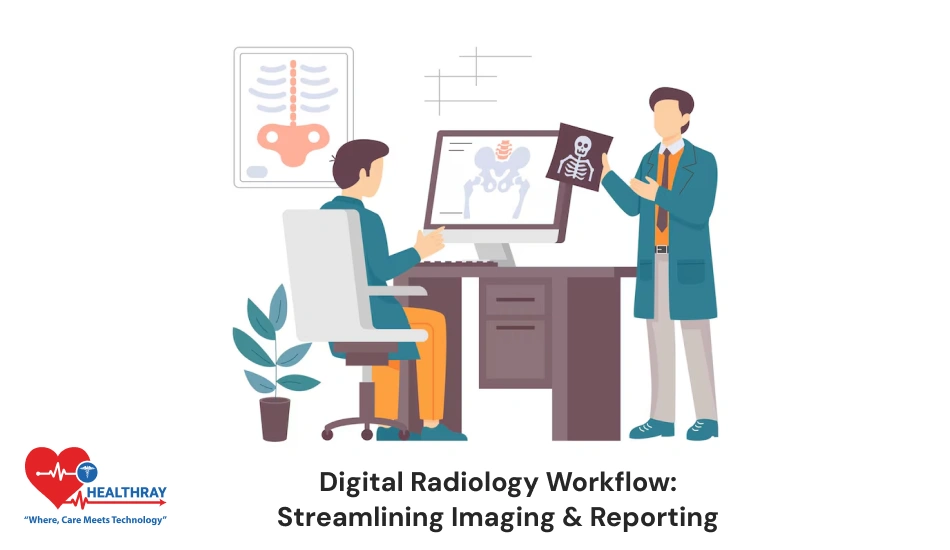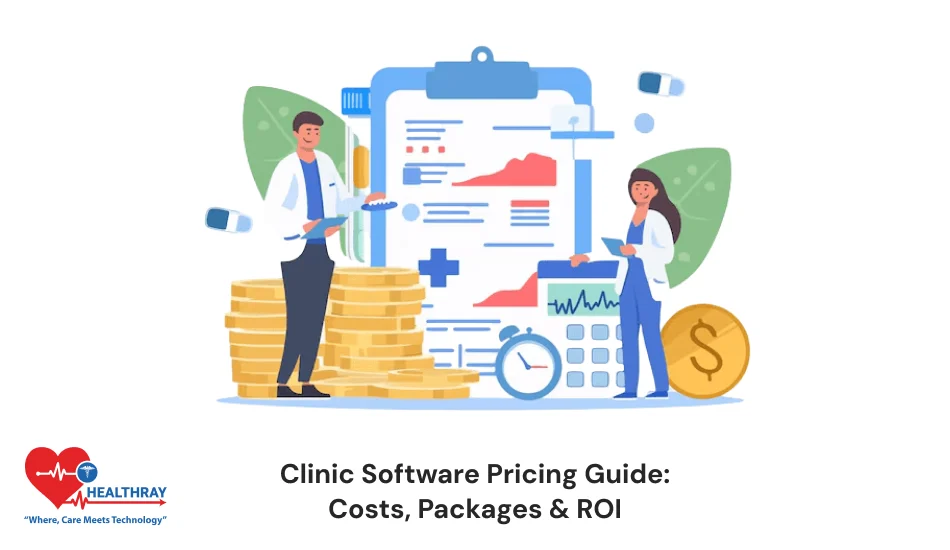Quick Summary
User-friendly interfaces, solid security measures, information compatibility interoperability, customizable layouts, clinical decision support tools, and adaptability to permit future expansion and innovative improvements are all fundamental components of Electronic Health Records (EHR) frameworks.
Introduction
Electronic health record systems have become a golden standard for all healthcare facilities. They can support the gathering, storing, and sharing of medical data across and within healthcare facilities. Not only are they responsible for eliminating paperwork, but they can also access information regarding patient health. Moreover, they also ensure compliance with regulatory laws like HIPAA.
EHR frameworks serve as a link between the conveyance of high-quality healthcare and technological advancements. Moreover their purpose is to offer a practical, reliable, and easy-to-use solution to the healthcare and record administration issue. It is likely common knowledge that they need help to establish and maintain. Anyway, what is an EHR system’s core functionality?
Hence in this blog, we will dig further into the topic of electronic health record frameworks. Moreover we’ll define an EHR Software, go over the advantages of Electronic Medical Records (EMR/EHR) Solution, and discover what features are fundamental for any EHR framework and how to get them.
What are electronic health records?
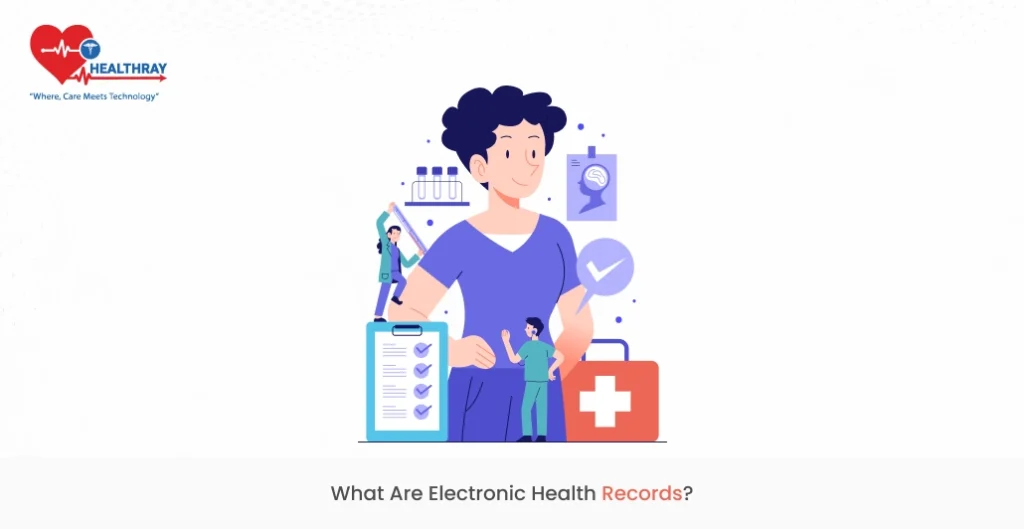
The most common definition for electronic health records is software that is made especially for capturing, storing, and exchanging medical information. Hence in this modern and fast-paced world, the functions of medical help go way beyond just assigning a physician for treatment. Instead, it involves combined efforts from multiple departments, including
- clinic expert
- lab personnel
- pharmaceutical stores
- emergency facilities
- facilities for older adults and disabled
Hence you might be shocked to know that EHRs are a familiar term in the healthcare world. The first electronic medical records registry happened way back in the 1970s. Hence from that day until today, EHRs have taken over innumerable functions that help people, from reception desks to clinical operations. EHR systems have a higher capacity for creating valuable experiences for patients and clinicians.
Benefits of EHR for medical practitioners include:
- instant access to the patient’s information
- sharing health information between parties
- Preventing misunderstandings between patients and providers
- reducing the likelihood of mistakes
- assisting with diagnosis
- Providing accurate prescriptions
- Streamlining the billing process
- Handling data securely with HIPAA compliance
Benefits of EHR for patients include:
- Ensuring the accuracy of the patient information
- Access to health information anytime and anywhere
- Avoiding unnecessary and repetitive medical tasks
- Automatic generation of insurance claims
How does electronic health records function?
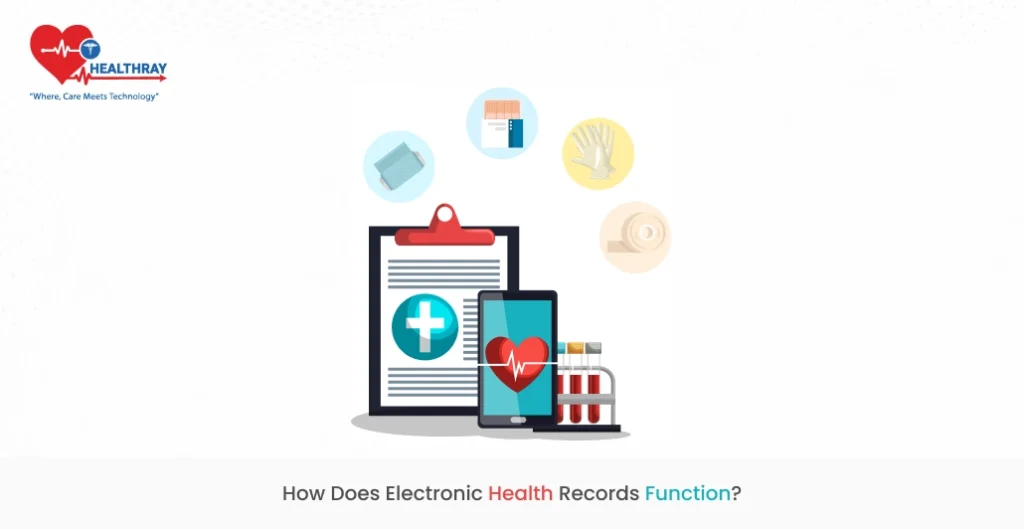
EHR software makes health information technology organization easier, clinical operations run more smoothly, and patients get superior treatment. How does EHR software work, though?
Electronic health records are interwoven over the entirety of the healthcare framework. Hence here’s an illustration of utilizing EHR software in a consistent step-by-step way:
Step 1: The patient looks toward the clinic. Upon entry, visitors provide information about their medical history, surgeries, allergies, and other individual details. Moreover after that, the patient can check subtle elements of their visit, appointments, medicines, and other clinical data by logging into their online medical account.
Step 2: Utilizing a scheduling framework, the front desk receptionist schedules a visit with the specialist. Hence the framework automatically synchronizes the physician’s schedule to decide the best time for the upcoming appointment.
Step 3: After getting a notice of the appointment, the doctor surveys the patient’s particulars in an electronic health record on the chart. Hence following the visit, the doctor enters the conclusion, a detailed plan of care, and medicines into the electronic medical record.
Step 4: The framework sends the medicines to the pharmacy. Hence the latter starts gathering them so that the arrangement is wrapped up when the patient arrives.
Step 5: The bill is generated automatically by the EHR platform and is sent to the patient via the financial office.
Step 6: The protection claim is issued by the system, which makes sure that the format fulfills the necessities of the patient’s protection company.
Step 7: A medical laboratory may also be granted access to the Electronic Health Records in the event that a patient needs to undergo lab testing. Hence upon request, a physician has access to the test findings.
What are the main functions of electronic health record software?
For front office units
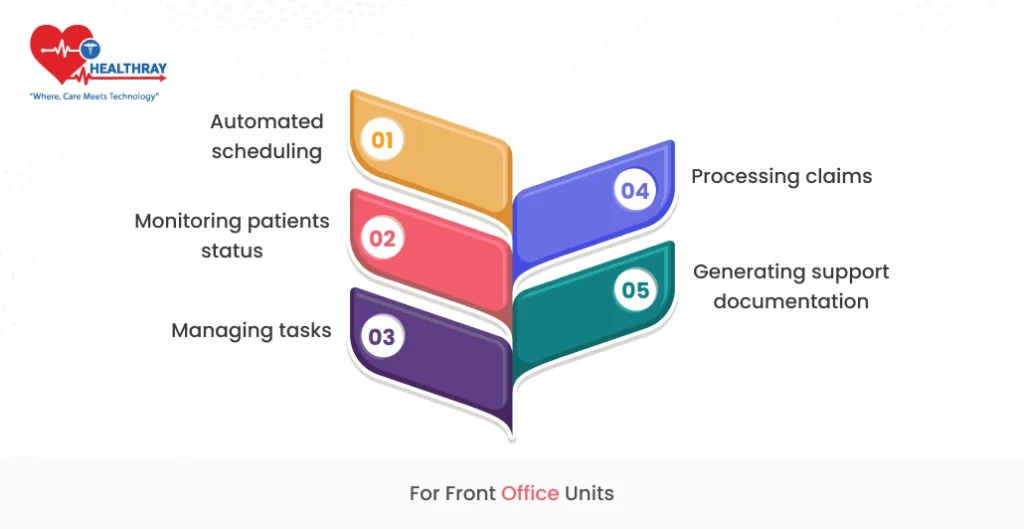
- Automated scheduling
EHR systems are known to input details into the scheduling system to inform patients about the most recent appointments.
- Monitoring patients’ status
The EHR software is known to track the health status of patients and send an update regarding it to the people on the reception desk. Moreover workers can send wait notifications and keep an eye on patient records at peak times thanks to this usefulness.
- Managing tasks
In expansion, the Electronic Health Records assigns tasks, delegates and diverts them to other parties, and tracks their achievement.
- Generating support documentation
Clinical documentation, counting personal healthcare plans, rules, conventions, medical errors, etc., can be produced utilizing EHR software.
- Processing claims
With the offer assistance of the system, a clinic may screen client satisfaction levels and provoke activity to secure its reputation.
For the doctor’s support unit
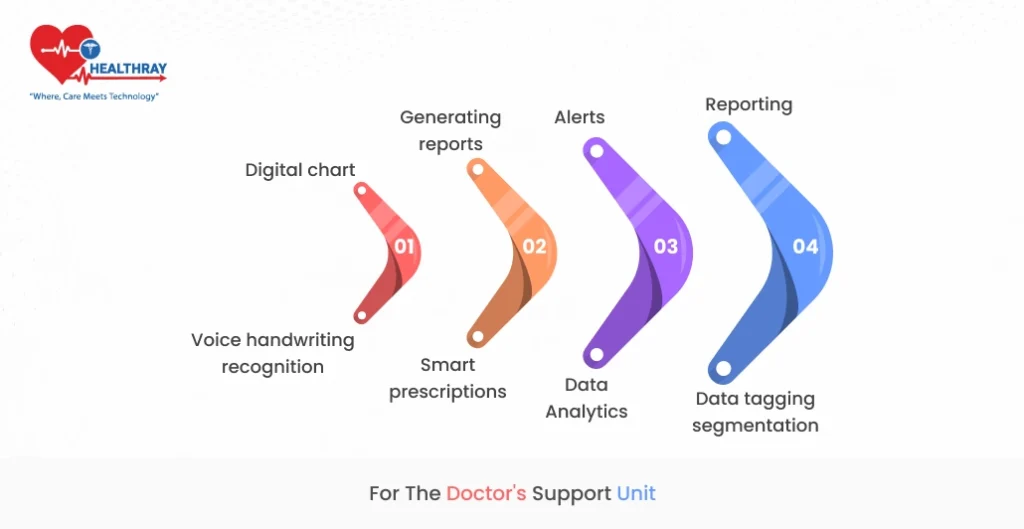
- Digital chart
The EHR platform compiles all paper records and data about a particular visitor into an electronic chart. This effortlessly accessible report contains the patient’s medical history, treatment history, personal data, test results, radiological pictures, and medication drugs. It also includes a particular person’s billing and insurance data.
- Voice and handwriting recognition
Specialists can enter patient information into an electronic chart utilizing EHR apps using various methods. Moreover including counting by voice input, electronic form completion, and handwriting recognition.
- Generating reports
EHR frameworks can create reports pertaining to a particular patient’s treatment plans, clinical notes, medicine records, and informational records. Hence based on the patient’s visit type and current clinical needs, specialists can plan personalized templates.
- Smart prescriptions
The EHR sends the list of suggested drugs straight to the pharmacy. Moreover, the framework decides on the best doses by analyzing drug compatibility.
- Alerts
The framework informs patients and healthcare organizations about the fundamental steps to follow and when particular activities are due. Hence the EHR app keeps track of the progress notes of the patient’s adherence to the prescribed course of care.
- Data Analytics
The innovation finds users who have the least secure medical issues and gives access to data that may be utilized to decide the best course of activity.
- Reporting
Public wellbeing registries can receive information from EHR frameworks to help in following the general health of the populace.
- Data tagging and segmentation
To protect patient protection, EHR apps can assign certain patient information as classified and, as it were, disclose a portion of the patient’s medical chart.
For billing unit
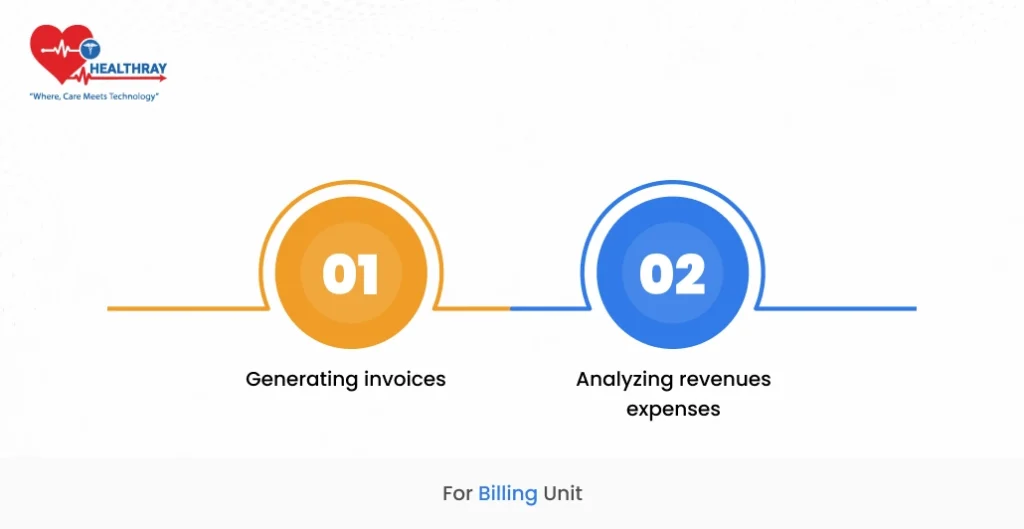
- Generating invoices
The EHR framework naturally makes bills following each visit, gathers and submits claims to the various patient care well’s insurance suppliers. In addition, it manages system exclusions, outstanding claims, and claim denials.
- Analyzing revenues and expenses
EHR frameworks monitor salary sources, distinguish areas for rebuilding and enhancements, and provide experiences in the medical practice’s financial execution relative to other clinics.
What are tips for adopting electronic health records?
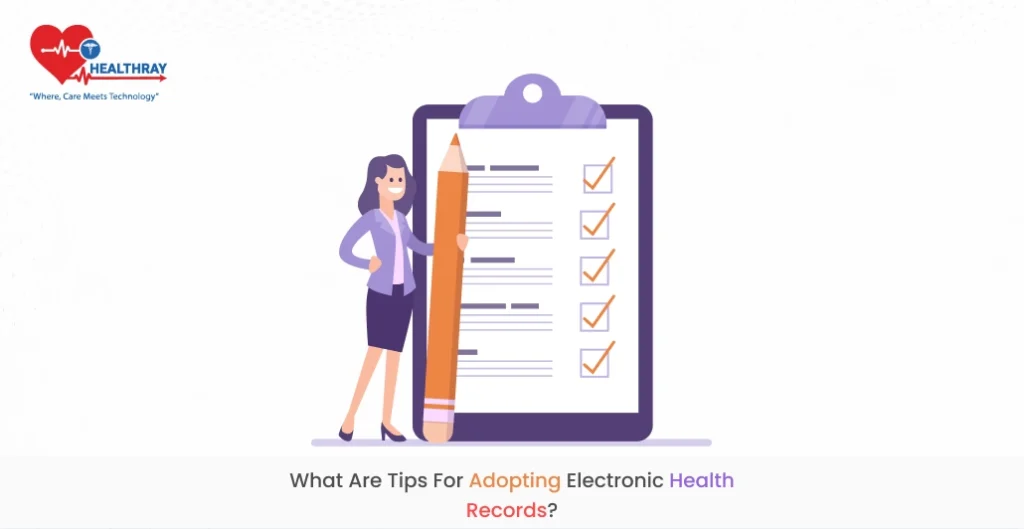
Check if you are ready.
EHR platforms are known to have higher efficiency, but you must make sure that you are ready to implement them in your hospital or not. Hence, assessing factors like
- business culture,
- acceptability by management,
- workflow, and
- operations
- condition of the information technology infrastructure
Some of the core beliefs and expectations when trying to adopt new software are employee knowledge, skill, and the level of EHR acceptance in the institution. Hence, this assessment will help you determine what is a successful way of implementing EHR systems.
Know your workflow
The second step is knowing your organization’s workflow. Hence, begin by analyzing your existing workflow by going through your patient’s treatment journey. Hence this will help you understand the best working process and improve it in the meantime. Also, think about how your EHR Hospital Systems are going to transform operations.
Develop a roadmap
A roadmap is a document that should provide a detailed explanation of each task completed by your employees in order to guarantee the effective creation and implementation of an EHR system.. Hence implementing EHR may require a set of specific actions from clinic staff.
This road map will assist you in staying on course and provide a workable EHR plan.. Moreover, another rule is that you must know that your organization’s health is adequate and that it is ready to accept the new software.
Select an EHR solution
By now, you must be completely aware of the needs of your organization. It is easy for you to understand the right software that can work for your organization. Hence as you are on your journey to select your EHR system, consider the following things:
- Choose hosting type: cloud or on-premise
- Support across multiple platforms or devices
- Integration with other EHR systems
- Compliance with HIPAA and necessary rules
Nowadays, any EHR system might need to be more for your organization; you might need a custom EHR solution that can suit your needs. Hence below are some indicators that can indicate that you need EHR software for your healthcare organization:
- Your huge organization has plenty of interconnected processes
- You have unique and specific processes
- The process must be not in anyone’s touch, covering everything from hardware and software to everything
- Training a person to operate a ready-made solution will take more time
- You’re ready to make an investment in a special platform designed for your company.
The benefits of developing custom software over pre-made solutions are numerous.. It helps you meet 100% of your organization’s needs, has an easy learning process, no additional licensing fees, and real-time vendor support. Although it might take more time to create custom software, you must choose a reliable vendor like Healthray.
Adapt software as per your organization
Getting a custom-made software solution will help you save a significant amount of time while configuring it and tailoring it to your needs, which is a lengthy process. Usually, this process takes place in different stages:
- Adjust your existing process to match the level of the new EHR system.
- Maintain and update the current hardware and software..
- Training employees
- Confirming third-party integrations that integrate with similar systems
Check and prepare
You are presently preparing to release the new software. Moreover to guarantee that you are ready to start utilizing EHR, you must total the following preliminary tasks:
- Test your security and IT systems;
- Act out a patient visit to evaluate how things move well and make the required enhancements, if needed, and
- Have a plan in place for settling the issue: Advise your vendor of the launch date and request their help. A staff member ought to know who to contact if things get out of control.
In spite of the fact that you have the alternative to roll out the framework all at once, it makes the most sense to do so steadily in order to maintain a strategic distance from any potential issues along the way and permit your representatives a few times to get utilized to the unused setup. Hence some time recently, you began using your modern EHR framework and were encouraged that issues and challenges would definitely arise. Allow your workers satisfactory guidance and direction to make the move simpler.
Evaluate and improve
Does your EHR framework live up to the claims of increased proficiency and improved patient care and fulfillment? The only way to learn is through ongoing observation and evaluation. Pay attention to your staff and clientele. Are they fulfilled with the EHR system? Which issues do they usually say, and what are the essential challenges they face?
Second, choose which metrics—profitability, volume of exchanges, and workflow efficiency—are most vital to your performance. To decide whether there have been progressions, compare the changes in these measurements following the presentation of the EHR.
Step towards digital era with our healthcare solution
Revamp your hospital facilities and embrace change for better healthcare management. Ease in managing and organizing large medical datasets leads to effective analysis. Seize the opportunity now!
Need a custom-built EHR software? Healthray can be a great choice!
Are you attempting to discover a particular Electronic Health Records (EHR) software program? You only need to look at Healthray! Regarded as one of the industry’s leading suppliers, Hence Healthray is an extraordinary choice for businesses looking for EHR software that is both feature-rich and versatile. Healthray gives a solid platform that is made to the specific requirements of healthcare suppliers thanks to its best-in-class features and unwavering commitment to quality.
One of the fundamental benefits of selecting Healthray is its great feature set. Moreover the EHR System from Healthray has a few features that are vital in today’s healthcare environments. Healthray provides a broad toolset to optimize processes and boost efficiency, extending from patient information administration to planning, billing, and other related capacities.
Besides, Healthray places a high value on the client experience, making sure that its software is straightforward and intuitive. Moreover, prioritizing ease of use not only boosts proficiency but also energizes user acknowledgment, ensuring a seamless move for medical practitioners.
Apart from its extensive feature set, Healthray stands out for its devotion to personalization. Healthray offers a wide range of customization alternatives to customize the software to individual needs, recognizing that each healthcare institution has diverse demands. Hence with the capacity to customize formats, set up workflows, and integrate third-party solutions, Healthray gives businesses the flexibility to tailor the program to their needs.
Besides, Healthray is a recognized partner for healthcare specialists worldwide due to its reputation for performance and dependability. Moreover Healthray’s track record of providing high-quality solutions gives its clients certainty and allows them to concentrate on providing awesome patient care.
Hence with its top-notch features, devotion to personalization, and stellar reputation, Healthray is prepared to provide healthcare suppliers with an effective and customized EHR platform.
Conclusion
The current healthcare environment is progressively dependent on electronic health records. If you or your company is considering creating a custom EHR system, we should make sure you are in the appropriate direction! Moreover no off-the-shelf solution can coordinate your demands like the EHR software created from scratch.
Your EHR system’s interesting functionality and user-centric design will please all stakeholders. But to do that, you’ll require a software development vendor who is knowledgeable, dependable, and experienced. Particularly in the healthcare industry, Healthray has years of involvement in creating software solutions from the ground up.


